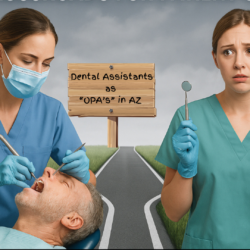Recent dental legislation changes have moved to expand the dental assistant’s scope of practice, allowing for them to scale supramarginally with just a couple hundred hours of training. These changes have left some in the dental hygiene community feeling even more undervalued and potentially replaceable. Let’s take a gentle pause on that for a moment, and turn our focus to what April is designated for: Oral Cancer Awareness Month.
Scaling teeth is the least of what a dental hygienist does, and April reminds me that the people in my chair depend on me to show up and pay closer attention – their lives may depend on it.
The Silent Killer in the Chair: Understanding the Threat of Oral, Pharyngeal, and Throat Cancers
Oral and oropharyngeal cancers are not rare anomalies—they’re an escalating epidemic. In 2024, over 54,000 Americanswere diagnosed with oral or pharyngeal cancer. That’s roughly one person every 10 minutes. This isn’t just about numbers—it’s about your patients. The people who trust you with their care every six months.
The five-year survival rate for oral cancer hovers around 65%, but that rate drops significantly when diagnosis happens late. Here’s the kicker: Early detection raises survival rates to over 80%. That’s where you, the registered dental hygienist, come in.
The Hygienist’s Role: You’re Not “Just Cleaning Teeth”—You’re Saving Lives
Let’s set the record straight: the clinical expertise of a licensed dental hygienist is irreplaceable. Your eyes, hands, instincts, and training are essential when it comes to detecting abnormalities in the mouth, throat, and neck that could be signs of early cancer. You are the first responder in the dental operatory.
A proper head, neck, and intraoral evaluation isn’t extra—it’s essential. But here’s the hard truth: it’s not always being done.
Why?
- Lack of time: Overbooked schedules mean assessments get skipped.
- Lack of training: Not every hygienist has had comprehensive education on cancer screenings or how to document a suspicious lesion.
- Lack of resources: Without tools like VELscope or educational support, detection becomes guesswork instead of precision.
Skipping this screening could mean missing a diagnosis that might cost someone their life.
Senate Bill 1124: A Wake-Up Call for Our Profession
Arizona’s recent passing of Senate Bill 1124, allowing dental assistants to be classified as “Oral Preventive Assistants,” sent shockwaves through the profession. While well-intended to increase access to care, the unintended consequence was this: it sent a message that the specialized, clinical work of a dental hygienist could be replicated by someone with less training.
Many hygienists felt undervalued, unappreciated, and professionally diminished.
And that’s not okay.
This bill should serve as a rallying cry. A reminder that clinical excellence matters.
What Sets a Registered Dental Hygienist Apart?
You’ve got years of training, licensure, continuing education, clinical hours, and patient care experience. You have the ability to:
- Detect and document suspicious lesions with clinical accuracy
- Communicate findings with appropriate referral protocols
- Use advanced tools like VELscope for early cancer screening
- Build rapport and trust that increases case acceptance and patient compliance
- Support a practice’s ROI by delivering life-saving services that patients value
These skills are not interchangeable. They are earned.
Challenges of Lower-Skilled Providers: What Dental Offices Must Consider
Bringing in undertrained, lower-skilled team members may sound efficient on paper. But in practice?
- Workflows suffer without clear clinical leadership
- Communication breakdowns lower case acceptance
- Patient trust erodes when expertise is inconsistent
- Return on investment tanks when care is reactive instead of preventive
- The entire team—from front desk to back office—needs training, coaching, and clarity to support new roles
You can’t scale excellence if you’re not anchored in it first.
Time to Reflect: Are You Bringing Clinical Excellence to the Chair?
Let’s get personal. Ask yourself:
- Are you consistently screening for oral cancer at every visit?
- Do you know how to document, photograph, and refer appropriately?
- Are you confident in your verbiage when speaking to patients about a suspicious area?
- Do you have access to advanced screening technology like VELscope?
- Do you have the discipline to deliver excellence, no matter how busy the schedule?
If not—it’s time.
Your next step might be advanced training in oral pathology, screening verbiage, lesion documentation, or device-assisted detection. Your patients need you to show up with confidence, every single time.
Real-World Stories, Real-World Impact
A hygienist in New Mexico identified a small ulcer on the lateral tongue of a 34-year-old nonsmoker. The lesion had only been present for 2 weeks. A biopsy confirmed early-stage squamous cell carcinoma. The patient underwent treatment and is now cancer-free.
Another hygienist in Oregon noticed subtle asymmetry under the jawline during a routine head and neck exam. A CT scan later revealed early lymphoma. That patient? He’s alive today because of that early catch.
You are not “just a hygienist.” You are the reason patients survive.
Take the Lead. Change the Outcome.
Make oral cancer detection one of the pillars of your practice—not just a box to check, but a standard to champion.
Let your colleagues, doctors, and legislators know:
A licensed, trained, passionate hygienist is not replaceable.
They are vital.
And if we want to be recognized as professionals, we must continue to act like it—every patient, every visit, without exception.
It’s time to rise, protect our profession, and put our clinical excellence on display—because lives are depending on it.
Dental Laser Integrations
Educating dental teams to elevate patient care, improve outcomes, and lead with laser precision.
Citations:
- Incidence and Mortality of Oral and Pharyngeal Cancers
- Source: American Cancer Society. Cancer Facts & Figures 2024.
https://www.cancer.org/research/cancer-facts-statistics.html
In 2024, approximately 54,540 people in the United States will be diagnosed with oral or oropharyngeal cancer, and about 11,580 will die from the disease.
- Survival Rates and Importance of Early Detection
- Source: National Cancer Institute. SEER Cancer Statistics Review.
https://seer.cancer.gov/statfacts/html/oralcav.html
The 5-year relative survival rate for localized oral cavity and pharynx cancer is approximately 86%, but drops to 48% when the cancer has spread to regional lymph nodes and 29% with distant metastasis.
- Role of HPV in Oral Cancer
- Source: Centers for Disease Control and Prevention (CDC). HPV-Associated Oropharyngeal Cancers.
https://www.cdc.gov/cancer/hpv/statistics/headneck.htm
HPV, especially HPV type 16, is a significant cause of oropharyngeal cancers, particularly in younger, nonsmoking patients.
- Importance of Routine Dental Visits in Cancer Detection
- Source: National Institute of Dental and Craniofacial Research (NIDCR). Oral Cancer.
https://www.nidcr.nih.gov/health-info/oral-cancer
Dental professionals are often the first to notice signs of oral cancer. Routine dental visits are crucial for early detection and improved outcomes.
- The Role of Dental Hygienists in Early Detection
- Source: The Oral Cancer Foundation. Early Detection and the Role of the Dental Professional.
https://oralcancerfoundation.org
Dental hygienists who perform comprehensive head and neck exams during routine care are instrumental in detecting cancer at its earliest stages, improving survival rates.
- Screening Technology (e.g., VELscope)
Source: American Society of Clinical Oncology (ASCO). Clinical Practice Guidelines for Head and Neck Cancer.
https://www.asco.org
Adjunctive screening tools like tissue fluorescence visualization (e.g., VELscope) may assist clinicians in identifying potentially malignant disorders, although they should be used in conjunction with a thorough visual and tactile exam.


